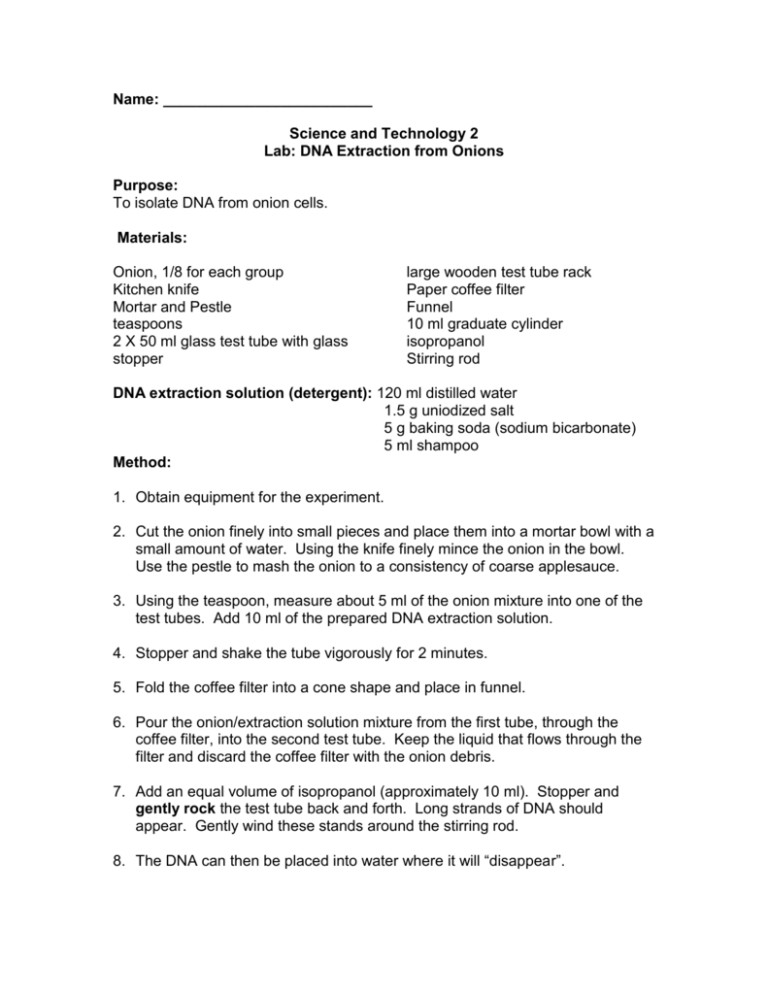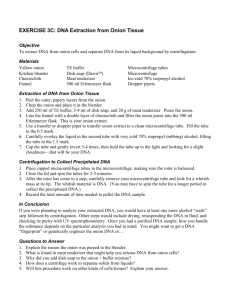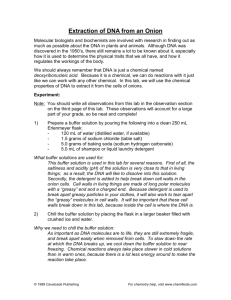DNA Extraction from Onions
advertisement

Name: _________________________ Science and Technology 2 Lab: DNA Extraction from Onions Purpose: To isolate DNA from onion cells. Materials: Onion, 1/8 for each group Kitchen knife Mortar and Pestle teaspoons 2 X 50 ml glass test tube with glass stopper large wooden test tube rack Paper coffee filter Funnel 10 ml graduate cylinder isopropanol Stirring rod DNA extraction solution (detergent): 120 ml distilled water 1.5 g uniodized salt 5 g baking soda (sodium bicarbonate) 5 ml shampoo Method: 1. Obtain equipment for the experiment. 2. Cut the onion finely into small pieces and place them into a mortar bowl with a small amount of water. Using the knife finely mince the onion in the bowl. Use the pestle to mash the onion to a consistency of coarse applesauce. 3. Using the teaspoon, measure about 5 ml of the onion mixture into one of the test tubes. Add 10 ml of the prepared DNA extraction solution. 4. Stopper and shake the tube vigorously for 2 minutes. 5. Fold the coffee filter into a cone shape and place in funnel. 6. Pour the onion/extraction solution mixture from the first tube, through the coffee filter, into the second test tube. Keep the liquid that flows through the filter and discard the coffee filter with the onion debris. 7. Add an equal volume of isopropanol (approximately 10 ml). Stopper and gently rock the test tube back and forth. Long strands of DNA should appear. Gently wind these stands around the stirring rod. 8. The DNA can then be placed into water where it will “disappear”. What’s Happening: Every living cell contains DNA. This includes cells from animals, bacteria, fungi and plants. A membrane composed of lipids and proteins surrounds each cell. By cutting the onion into very small pieces the cell membranes are broken open. Mixing with the DNA extraction solution allows the lipids and proteins to be solubilized by the detergent in the shampoo. When poured through the coffee filter the cellular debris is trapped, however, the DNA is able to flow through. The baking soda (in the DNA extraction solution) acts as a buffering agent that keeps the solution at an optimal pH for the DNA. The salt, in combination with the isopropanol, precipitates the DNA, since DNA is not soluble in isopropanol. Therefore, the addition of isopropanol allows the DNA to be seen by the naked eye. The DNA seems to disappear when it is placed into water because in water, DNA is soluble. http://www.slideshare.net/meganrice/dna-extraction-principles Homework Assignment: due next class Question: How did this procedure allow you to isolate DNA from onion cells? 1) Read the above paragraph 2) View the powerpoint presentation on the link above 3) If you still don’t understand, do some more research of your own. Task: Answer the question above by doing the following: 1) Create a 4 frame cartoon to illustrate, scientifically, what’s happening in each of the steps you followed in this lab. 2) Write 2-3 setences to explain your drawing in each frame. Step 1: Cutting and mashing Step 2: Dissolution with the DNA extraction solution “detergent” (including salt- NaCl) Step 3: Filtration Step 4: Precipitation You may do this on computer, but the images must be original. Grading scheme: Competency 3 (Use of scientific language and diagrams) 5= advanced 4 = thorough 3 = acceptable 2 = partial 1 = minimal









